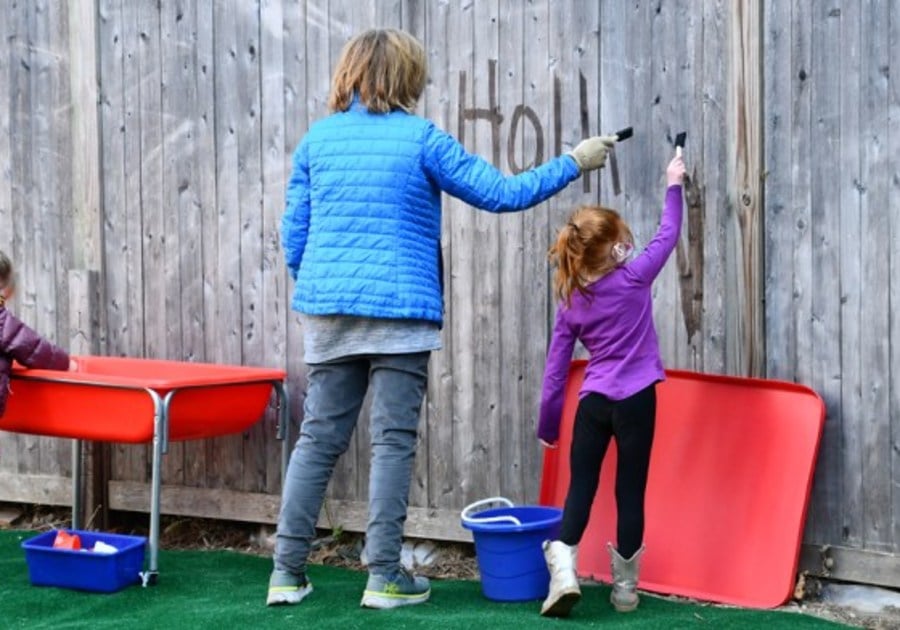For the past eight years, students and teachers have made good use of the school’s private four-acre Outdoor Classroom atop Sunflower Hill — just across the street from the main campus. Year-round and in all kinds of weather, students of all ages use the nature trails, gardens and creative learning stations as part of their integrated Montessori curriculums.
But starting this fall, to expand outdoor learning even further, each Children’s House (CH) preschool class also has a “mini outdoor classroom” of its own. Sturdy 15-foot tents outside each of the four CH classrooms house covered Montessori environments, each one stocked with inviting tactile materials for active, play-based learning. New fences create enclosures so each class has a safe and cozy space of its own.
“There must be provision for the child to have contact with nature, to understand and appreciate the order, the harmony and the beauty in nature… so that the child may better understand and participate in the marvelous things which civilization creates.” -Maria Montessori
 |  |
What will preschoolers find in their mini outdoor classrooms?
- Mud kitchens (for making mud pies — or whatever they dream up!)
- Wheelbarrows and wooden wagons
- Natural balance beams and stackable tree stumps
- Organic materials and objects found in nature
They’re also able to bring their indoor work outdoors to change things up and make new discoveries. With classroom doors connecting each indoor/outdoor space, it’s an easy and natural extension.

A student or teacher might bring the Moveable Alphabet box from the indoor space to the outdoor space, for instance, and use it with objects found in nature. Think: “A is for acorn, S is for stick!” The possibilities are endless, especially in a Montessori preschool.
Nature studies are an integral part of Montessori education
“Our goal is to be outside as much as possible, weather permitting, and to strive for the best balance between the two,” explains Dee Slavin, Director of the Lower School. “Maria Montessori believed in connecting children with nature, so this has always been part of our Montessori curriculum. Our children work in our school gardens, observe birds, name organic objects. Now, with physical distancing in mind, we’re taking it to a new level.”
“Modern observations and child-study have led us to realize that as soon as the child can go out of doors, we must take him with us.” -Maria Montessori
According to Montessori philosophy, immersion in nature spurs the growth of the “whole child” — by nurturing physical, social, emotional and cognitive development. It also sparks curiosity and encourages young naturalists to think about the bigger world around them. Spending more time in nature is healthy for emotional and mental health during childhood, adolescence and adulthood. What’s more, it inspires children to be environmentally responsible citizens throughout their lifetimes.

To prepare for more outdoor learning during the new school year, Inly teachers participated in various professional development opportunities, including a virtual workshop with the Boston Outdoor Preschool Network (BOPN). During a free summer workshop, BOPN colleagues shared tips from their collaborations with the Arnold Arboretum, Massachusetts Horticultural Society and other organizations.
BOPN is inspired by forest kindergartens in Germany, Scandinavia, and the United States.
Started in Europe, nature-immersive preschools have been shown to support physical and mental health, creativity, problem-solving, cooperation, academic performance, social skills, and executive function.
Physical Distancing: How does it all work?
In each Children’s House classroom there are two “home groups” of 10 students each. While one is indoors in the main classroom, the other is outdoors in the extension. On days when the weather prevents the use of the outdoor space, classes will use a secondary indoor space to minimize the mixing of student groups. Following each two-week break in the Winter and Spring, home group assignments will be changed to allow for additional social interaction and peer-group development.
For more information, see Inly’s Reopening Plan.
Learn more about Inly’s Outdoor Classroom here.



